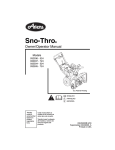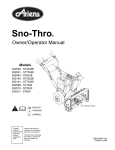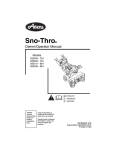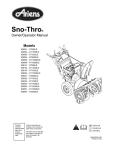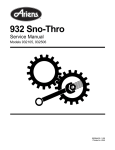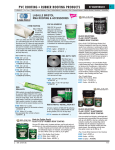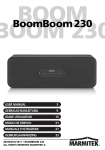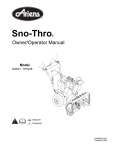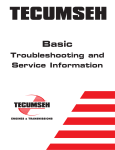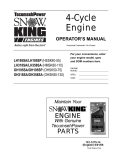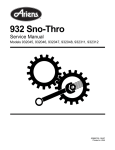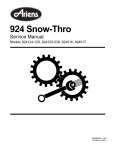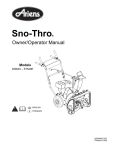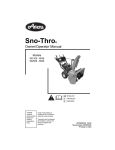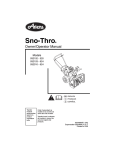Download Ariens 932507 - 520 Specifications
Transcript
Sno-Thro ® Owner/Operator Manual Models 932037 - 724 932038 - 5520 932039 - 624 932505 - 724 932507 - 520 932508 - 624 U.S. Patents Pending ENGLISH FRANÇAIS ESPAÑOL Transfer model & serial number label from product registration here. Coller l’autocollant du modèle et du numéro de série dans cet encadré. Transferir aquí la etiqueta del modelo y número de serie del registro del producto. 00295500A 7/04 Supersedes 00295500 Printed in USA Ariens Company 655 West Ryan Street P.O. Box 157 Brillion, Wisconsin 54110-0157 USA Telephone (920) 756-2141 Facsimile (920) 756-2407 EC DECLARATION OF CONFORMITY ISSUED BY THE MANUFACTURER DÉCLARATION DE CONFORMITÉ CE ÉMISE PAR LE FABRICANT – EU-ÜBEREINSTIMMUNGSERKLÄRUNG DES HERSTELLERS – DICHIARAZIONE DI CONFORMITÀ CE RILASCIATA DAL PRODUTTORE – DECLARACIÓN DE CONFORMIDAD CE EMITIDA POR EL FABRICANTE – EF-SAMSVARSERKLÆRING FRA PRODUSENTEN – EG-DEKLARATIONEN OM ÖVERENSSTÄMMELSE UTFÄRDAD AV TILLVERKAREN – VALMISTAJAN ANTAMA EY-VAATIMUSTENMUKAISUUSVAKUUTUS – DEKLARACJA ZGODNOŚCI Z PRZEPISAMI EC WYDANA PRZEZ PRODUCENTA – We the undersigned, ARIENS COMPANY, certify that: Nous, soussignés ARIENS COMPANY, certifions que : Der Unterzeichnete, ARIENS COMPANY, bescheinigt, dass: La sottoscritta società ARIENS COMPANY certifica che: Nosotros, los abajo firmantes, ARIENS COMPANY, certificamos que: Undertegnede, ARIENS COMPANY, bekrefter at: Undertecknad, ARIENS COMPANY, intygar att: Allekirjoittanut, ARIENS COMPANY, vakuuttaa, että: My, niźej podpisani, ARIENS COMPANY, oświadczamy, że: Type: Type : Typ: Tipo: Tipo: Type: Typ: Tyyppi: Typ: WALK BEHIND SNOW THROWER – LES CHASSES-NEIGE AUTOTRACTÉS – HANDGEFÜHRTE SCHNEEFRÄSE – SPAZZANEVE SEMOVENTE – CAMINAR POR DETRÁS DE LA LANZADORA DE NIEVE – SNØFRESER – SJÄLVGÅENDE SNÖSLUNGA – KÄSINOHJAILTAVA LUMILINKO – ODGARNIACZ ŚNIEGU DO PROWADZENIA PRZED SOBĄ Trade Name: Appellation commerciale : Handelsbezeichnung: Nome commerciale: Nombre comercial: Handelsnavn: Handelsbeteckning: Kauppanimi: Nazwa handlowa: Ariens Model: Modèle : Modell: Modello: Modelo: Modell: Modell: Malli: Model: 932505, 932507, 932508 Conforms to: Est conforme à : Mit den Anforderungen der folgenden Richtlinien übereinstimmt: È conforme a: Cumple con: Er i samsvar med: Överensstämmer med: Täyttää seuraavat vaatimukset: Jest zgodny z: 98/37/EC, 89/336/EEC, 2000/14/EC Conformity Assessment Annex V. Annexe V de l'évaluation de conformité. Konformitätsbewertung, Anhang V. Annesso V della valutazione di conformità. Anexo V de la evaluación de la conformidad. Samsvarsvurdering etter vedlegg V. Bedömning av överensstämmelse Bilaga V. Vaatimustenmukaisuuden arviointi, liite V. Dodatek V, Ocena zgodności. Representative Measured Sound Power Level (Lwa) – Niveau de puissance acoustique représentatif mesuré (Lwa) – Repräsentativer gemessener Geräuschpegel (Lwa) – Livello di potenza sonora rappresentativo rilevato (Lwa) – Nivel de potencia acústica representativo medido (Lwa) – Representativt målt lydeffektnivå (Lwa) – Representativ uppmätt ljudnivå (Lwa) – Tyypillinen mitattu äänitehotaso (Lwa) – Zmierzony reprezentatywny poziom mocy akustycznej (Lwa) – Guaranteed Sound Power Level (Lwa) – Niveau de puissance acoustique garanti (Lwa) – Garantierter Geräuschpegel (Lwa) – Livello di potenza sonora garantito (Lwa) – Nivel de potencia acústica garantizado (Lwa) – Garantert lydeffektnivå (Lwa) – Garanterad uppmätt ljudnivå (Lwa) – Taattu äänitehotaso (Lwa) – Gwarantowany reprezentatywny poziom mocy akustycznej (Lwa) – 932505: 100 dBA 932505: 104 dBA 932507: 103 dBA 932507: 107 dBA 932508: 100 dBA 932508: 104 dBA 2 Fred J. Moreaux: Quality and Conformance Manager (Keeper of Technical File) Responsable de la qualité et de la conformité des produits (Dépositaire de la fiche technique) Manager Qualitätssicherung und Konformität (Archivar der technischen Akte) Responsabile della qualità e della conformità del prodotto (Depositario del file tecnico) Gerente de calidad y conformidad (Depositario del archivo técnico) Kvalitet- og samsvarsansvarlig (innehaver av tekniske data) Chef för kvalitet och produktöverensstämmelse (Innehavare av tekniska data) Laadusta ja vaatimustenmukaisuudesta vastaava päällikkö (Teknisen tiedoston haltija) Kierownik do spraw jakości i zgodności (Przechowujący Dokumentację Techniczną) Ariens Company Brillion, WI 54110-0157 USA Signature Signature Unterschrift Firma Firma Signatur Namnteckning Allekirjoitus Podpis 5/10/2004 Date Date Datum Data Fecha Dato Datum Päiväys Data CE Sound and Vibration – Niveau sonore et vibration CE – CE-Geräuschpegel und Vibrationswerte – Livello sonoro e vibrazioni CE – Sonido y vibración CE – CE-lydnivå og Vibrasjonsmåling – CE ljudnivå och Vibrations-mätning – CEmelutaso Tärinä – CE Dźwięku i Wibracji Model: – Modèle : – Modell: – Modello: – Modelo: – Modell: – Modell: – Malli: – Model: 932505 932507 932508 Oper. Ear Sound Pressure (Lpa) in dBA – Pression acoustique Pression sonore à aux oreilles de l’opérateur (Lpa) en dBA – Geräuschstärke am Ohr des Bedieners (Lpa) in dBA – Potenza sonora percepita dall’operatore (Lpa) in. dBA – Presión de sonido en el oído (Lpa) in dBA – Lydtrykk i førerens øre (Lpa) in. dBA – vid förarens position (Lwa) i dBA – Kuljettajan korvaan kohdistuva äänipaine (Lpa)/dBA – Robocze ciśnienie akustyczne na uchu (Lpa) w decybelachA 88 89 88 2 Vibration Measure (m/sec ) @ Operator Hands – Niveau de vibrationaux mains de l’opérateur – Vibrationswerte An den Händen des Bedieners – Misura delle vibrazioni alle mani dell’operatore – Cantidad de vibración en las manos del operador – Vibrasjonsmåling ved brukerens hender – Vibrationsmätning vid förarens händer – Tärinä kuljettajan käsissä – Pomiar wibracji (m/sec2) na rękach operatora X 4.1 6.5 4.1 Y 1.6 3.9 1.6 Z 2.6 5.5 2.6 3 TABLE OF CONTENTS Safety . . . . . . . . . . . . . . . . . . . . . . . . . . . . . . 5 Storage . . . . . . . . . . . . . . . . . . . . . . . . . . . . 26 Assembly . . . . . . . . . . . . . . . . . . . . . . . . . . . 9 Troubleshooting. . . . . . . . . . . . . . . . . . . . . 27 Controls and Features . . . . . . . . . . . . . . . 12 Service Parts . . . . . . . . . . . . . . . . . . . . . . . 27 Operation . . . . . . . . . . . . . . . . . . . . . . . . . . 13 Accessories . . . . . . . . . . . . . . . . . . . . . . . . 27 Maintenance. . . . . . . . . . . . . . . . . . . . . . . . 17 Specifications . . . . . . . . . . . . . . . . . . . . . . 29 Service and Adjustments . . . . . . . . . . . . . 19 Warranty . . . . . . . . . . . . . . . . . . . . . . . . . . . 30 INTRODUCTION THE MANUAL Before operation of unit, carefully and completely read your manuals. If used improperly, this unit could be dangerous and cause personal injury or property damage. The contents will provide you with safety instructions for the safe use of your unit during normal operation and maintenance. All reference to left, right, front, or rear are given from operator standing in operation position and facing the direction of forward travel. MODEL AND SERIAL NUMBERS When ordering replacement parts or making service inquiries, know the Model and Serial numbers of your unit and engine. Numbers are located on the product registration form in the unit literature package. They are printed on a serial number label, located on the frame of your unit. Serial Number Label Figure 2 OS0522 • Record Unit Model and Serial numbers here. • Record Engine Model and Serial number here. PRODUCT REGISTRATION The Ariens dealer must register the product at the time of purchase. Registering the product will help the company process warranty claims or contact you with the latest service information. All claims meeting requirements during the limited warranty period will be honored, whether or not the product registration card is returned. Keep a proof of purchase if you do not register your unit. Customer Note: If the dealer does not register your product, please fill out, sign, and return the product registration card to Ariens or go to www.ariens.com. UNAUTHORIZED REPLACEMENT PARTS Use only Ariens replacement parts. The replacement of any part on this vehicle with anything other than an Ariens authorized replacement part may adversely affect the performance, durability, or safety of this unit and may void the warranty. Ariens disclaims liability for any claims or damages, whether warranty, property damage, personal injury or death arising out of the use of unauthorized replacement parts. For a brief list of replacement parts see Service Parts in this manual. To obtain a complete parts manual, find your model and serial number. Then go to www.ariens.com or call 1-920-756-4688. GB - 4 © Copyright 2004 Ariens Company DISCLAIMER Ariens reserves the right to discontinue, make changes to, and add improvements upon its products at any time without public notice or obligation. The descriptions and specifications contained in this manual were in effect at printing. Equipment described within this manual may be optional. Some illustrations may not be applicable to your unit. DELIVERY Customer Note: If you have purchased this product without complete assembly and instruction by your retailer, it is your responsibility to: 1. Read and understand all assembly instructions in this manual. If you do not understand or have difficulty following the instructions, contact your nearest Ariens Dealer for assistance. Make sure all assembly has been properly completed. NOTE: To locate your nearest Ariens Dealer, call 1-920-756-4688 or go to www.ariens.com on the internet. WARNING: Improper assembly or adjustments can cause serious injury. 2. Understand all Safety Precautions provided in the manuals. 3. Review control functions and operation of the unit. Do not operate the Sno-Thro unless all controls function as described in this manual. 4. Review recommended lubrication, maintenance and adjustments. 5. Review Limited Warranty Policy. 6. Fill out a Product Registration Card and return the card to the Ariens Company or go to www.ariens.com. SAFETY WARNING: To avoid injury to hands and feet, always disengage clutches, shut off engine, and wait for all movement to stop before unclogging or working on snow thrower. Hand contact with the rotating impeller is the most common cause of injury associated with snow throwers. Never use your hand to clean out the discharge chute. Keep hands and feet away from auger and impeller. SAFETY ALERTS Look for these symbols to point out important safety precautions. They mean: WARNING: POTENTIALLY HAZARDOUS SITUATION! If not avoided, COULD RESULT in death or serious injury. CAUTION: POTENTIALLY HAZARDOUS SITUATION! If not avoided, MAY RESULT in minor or moderate injury. It may also be used to alert against unsafe practices. NOTATIONS NOTE: General reference information for proper operation and maintenance practices. IMPORTANT: Specific procedures or information required to prevent damage to unit or attachment. Attention! PRACTICES AND LAWS Personal Safety Is Involved! Practice usual and customary safe working precautions, for the benefit of yourself and others. Understand and follow all safety messages. Be alert to unsafe conditions and the possibility of minor, moderate, or serious injury or death. Learn applicable rules and laws in your area. Always follow the practices set forth in this manual. Become Alert! Obey The Message! The safety alert symbols above and signal words below are used on decals and in this manual. Read and understand all safety messages. DANGER: IMMINENTLY HAZARDOUS SITUATION! If not avoided, WILL RESULT in death or serious injury. GB - 5 REQUIRED OPERATOR TRAINING Original purchaser of this unit was instructed by the seller on safe and proper operation. If unit is to be used by someone other than original purchaser; loaned, rented or sold, ALWAYS provide this manual and any needed safety training before operation. SAFETY DECALS AND LOCATIONS ALWAYS replace missing or damaged Safety Decals. Refer to figure below for Safety Decal locations. WARNING / AVERTISSEMENT / ADVERTENCIA 1 08095700A DANGER/PELIGRO 2 ROTATING PARTS Stop engine and remove ignition key before clearing. ONLY use clean-out tool to clear blockages. NEVER use your hands. PIECES EN ROTATION Arreter le moteur et retirer la clé de contact avant le débourrage. N'utiliser QUE des outils de nettoyage pour désobstruer. NE JAMAIS utiliser les mains. PIEZAS GIRATORIAS Detener el motor y sacar la llave antes de despejar. Para limpiar obstrucciones se debe usar SOLAMENTE una herramienta adecuada. NUNCA se debe hacerlo con las manos. 08093901 DANGER / PELIGRO 3 ROTATING PARTS Keep clear of auger while engine is running. PIECES EN ROTATION Ne pas s'approcher du rotor lorsque le moteur est en marche. PIEZAS GIRATORIAS Mantenerse alejado del sinfín mientras que el motor esté en marcha. SAFETY SÉCURITÉ Read operator's manual. Lire le manuel du lopérateur. Allow operation only by Seuls les adultes ayant properly trained adult, recu la formation never children. appropriée peuvent Stop engine and remove utiliser la machine, ignition key prior to jamais les enfants. leaving operator's Toujours arrêter le position for any reason. moteur et retirer la clé de contact avant de quitter Keep all controls, guards le siège de l'opérateur. and safety devices properly serviced and Les commandes, functional. protections et dispositifs de sécurité doivent Never direct discharge toujours être towards persons or correctement entretenus property that may be et en bon état de injured or damaged by fonctionnement. thrown objects. Ne jamais orienter la goulotte d'évacuation vers des personnes pour éviter tout risque de blessure par des objets projetés ou vers des bâtiments pour éviter de les endommager. SEGURIDAD Leer el manual del operador. Permitir la operación sólo por adultos entrenados, nunca niños. Parar el motor y sacar la llave de la ignición antes de dejar el puesto del operador por cualquier motivo. Mantener todos los controles, protectores y dispositivos de seguridad correctamente y en buen funcionamiento. Nunca dirigir la descarga hacia personas que puedan lesionarse o propiedad que pueda dañarse por los objetos arrojados. 08094000A Figure 3 OS2440 1. WARNING! Never direct discharge towards persons or property that may be injured or damaged by thrown objects. Read Owner/Operator Manual. OL0910 OL1801 Keep people away from unit while operating. Keep children out of work area and under watchful care of a responsible adult. ONLY use clean-out tool to clear blockages. NEVER use your hands. OL4370 Wear appropriate hearing protection. Stop engine, remove key, read manual before making any repairs, adjustments. OL4690 OL4010 GB - 6 2. DANGER! OS6610 ROTATING PARTS! ONLY use clean-out tool to clear blockages. NEVER use your hands. High speed impeller rotates below discharge opening. Wait for all moving parts to stop before removing clogs or servicing. 3. DANGER! ROTATING PARTS. Keep clear of auger while engine is running. • Read Operator’s Manual. OS2080 • Allow operation only by properly trained adult, never children. • Stop engine and remove ignition key prior to leaving the operator’s position for any reason. • Keep all controls, guards and safety devices properly serviced and functional. • Never direct discharge towards persons or property that may be injured or damaged by thrown objects. SAFETY RULES Read, understand, and follow all safety practices in Owner/Operator Manual before beginning assembly or operating. Failure to follow instructions could result in personal injury and/or damage to unit. ALWAYS remove key and/or wire from spark plug before assembly, maintenance or service. Unintentional engine start up can cause death or serious injury. Complete a walk around inspection of unit and work area to understand: • Work area • Your unit • All safety decals ALWAYS check overhead and side clearances carefully before operation. ALWAYS be aware of traffic when operating along streets or curbs. Keep children and people away. Keep children out of work area and under watchful care of a responsible adult. NEVER allow children to operate or play on or near unit. Be alert and shut off unit if children enter area. DO NOT allow adults to operate unit without proper training. Keep area of operation clear of all toys, pets, and debris. Thrown objects can cause injury. Check for weak spots on docks, ramps or floors. Avoid uneven work areas and rough terrain. Stay alert for hidden hazards. Avoid uneven and rough terrain. DO NOT operate near drop-offs, ditches, or embankments. Unit can suddenly turn over if a wheel is over the edge of a cliff or ditch, or if an edge caves in. Falling snow, fog, etc. can reduce vision and cause an accident. Operate unit only when there is good visibility and light. Only trained adults may operate unit. Training includes actual operation. NEVER operate unit after or during the use of medication, drugs or alcohol. Safe operation requires your complete and unimpaired attention at all times. NEVER allow anyone to operate this unit when their alertness or coordination is impaired. DO NOT operate unit without wearing adequate winter outer garments. Wear adequate safety gear, including safety glasses with side shields, and protective gloves. Wear proper footwear to improve footing on slippery surfaces. DO NOT wear loose clothing or jewelry and tie back hair that may get caught in rotating parts. Protect eyes, face and head from objects that may be thrown from unit. Wear appropriate hearing protection. Avoid sharp edges. Sharp edges can cut. Moving parts can cut off fingers or a hand. ALWAYS keep hands and feet away from all rotating parts during operation. Rotating parts can cut off body parts. NEVER place your hands or any part of your body or clothing inside or near any moving part while unit is running. ALWAYS keep hands away from all pinch points. DO NOT touch unit parts which might be hot from operation. Allow parts to cool before attempting to maintain, adjust or service. GB - 7 Never direct discharge towards persons or property that may be injured or damaged by thrown objects. Use extreme caution on gravel surfaces. Stay alert for hidden hazards or traffic. Adjust Runners so Scraper Blade does not contact gravel. Abnormal Vibrations are a warning of trouble. Striking a foreign object can damage unit. Immediately stop unit and engine. Remove key and wait for all moving parts to stop. Remove wire from spark plug. Inspect unit and make any necessary repairs before restart. DO NOT throw snow any higher than necessary. Before cleaning, removing clogs or making any inspections, repairs, etc.: disengage clutch(es), stop unit and engine, remove key, allow moving parts to stop. Allow hot parts to cool. Deflected materials can cause injury and property damage. Always stand clear of the discharge area when operating this unit. Fumes from engine exhaust can cause injury or death. DO NOT run engine in an enclosed area. Always provide good ventilation. ALWAYS disengage attachment, stop unit and engine, remove key and allow moving parts to stop before leaving operator’s position. ROTATING IMPELLER CAN CAUSE SERIOUS INJURY. NEVER ATTEMPT TO UNCLOG OR CLEAN UNIT WHILE ENGINE IS RUNNING. Read, understand, and follow all instructions in the manual and on the machine before starting. Understand: • How to operate all controls. • The functions of all controls. • How to STOP in an emergency. Before starting engine, disengage control(s). Use only approved extension cords and receptacles when starting units equipped with electric starter. DO NOT connect electric starter cord to any wiring system that is not a three-wire grounded system. ALWAYS allow unit and engine to adjust to outdoor temperatures before clearing snow. Always be sure of your footing, especially when operating in reverse or leaving the operator’s position. Walk, never run during operation. DO NOT overload the machine capacity by attempting to clear snow at too fast a rate. DO NOT operate at too fast a rate. Slow down and turn corners slowly. Do not operate in reverse unless absolutely necessary. ALWAYS back up slowly. Always look down and behind before and while backing. Run unit a few minutes after clearing snow to prevent freeze-up of attachment. Disengage attachment when not in use. Disengage all clutches before starting engine. Adjust runners to clear gravel or crushed rock surfaces safely. Never leave a running unit unattended. ALWAYS shut off engine before leaving unit. ALWAYS remove key to prevent unauthorized use. Never carry passengers. Check clutch and brake operation frequently. Adjust and service as required. All motion of drive wheels and auger/impeller must stop quickly when control levers are released. DO NOT operate on steep slopes. DO NOT clear snow across the face of slopes. Keep all movement on slopes slow and gradual. DO NOT make sudden changes in speed or direction. Use a slow speed to avoid stops or shifts on slopes. Avoid starting or stopping on a slope. DO NOT park unit on a slope unless absolutely necessary. When parking on a slope always block the wheels. ALWAYS shut off engine, remove key, and close fuel shut-off valve or drain fuel when transporting unit on a truck or trailer. Use extra care when loading or unloading unit onto trailer or truck. Secure unit chassis to transport vehicle. NEVER secure from rods or linkages that could be damaged. DO NOT transport machine while engine is running. Keep unit free of ice or other debris. Clean up oil or fuel spills. Disengage attachment drive when traveling from one work area to another. GB - 8 This product is equipped with an internal combustion type engine. DO NOT use unit on or near any unimproved, forest-covered or brush covered land unless exhaust system is equipped with a spark arrester meeting applicable local, state or federal laws. A spark arrester, if it is used, must be maintained in effective working order by operator. Before tipping unit up onto housing, remove fuel so no spills will occur. Ensure unit is secure and will not tip over during maintenance. Fuel is highly flammable and its vapors are explosive. Handle with care. Use an approved fuel container. DO NOT change engine governor settings or over-speed engine. NO smoking, NO sparks, NO flames. ALWAYS allow engine to cool before servicing. NEVER fill fuel tank when engine is running or hot from operation. ALWAYS keep protective structures, guards, and panels in good repair, in place and securely fastened. NEVER modify or remove safety devices. Fumes from engine exhaust can cause injury or death. DO NOT run engine in an enclosed area. Always provide good ventilation. NEVER fill or drain fuel tank indoors. ALWAYS maintain unit in safe operating condition. Damaged or worn out muffler can cause fire or explosion. Replace fuel cap securely and clean up spilled fuel. Keep all hardware properly tightened. Check shear bolts frequently. Never fill containers inside a vehicle or on a truck or trailer bed with a plastic liner. Always place containers on the ground away from your vehicle before filling. Maintain or replace safety and instruction labels, as necessary. When practical, remove gas-powered equipment from the truck or trailer and refuel it on the ground. If this is not possible, then refuel such equipment on a trailer with a portable container, rather than from a gasoline dispenser nozzle. Keep the nozzle in contact with the rim of the fuel tank or container opening at all times until fueling is complete. Do not use a nozzle lockopen device. If fuel is spilled on clothing, change clothing immediately. NEVER store unit with fuel in fuel tank, inside a building where any ignition sources are present such as hot water heaters, space heaters, or clothes dryers. Allow the engine to cool before storing in any enclosure. Shut off fuel and allow engine to cool completely before storing in closed area or covering unit. For extended storage, clean unit thoroughly. See Engine Manual for proper storage. Use only attachments or accessories designed for your unit. Check components frequently. If worn or damaged, replace with manufacturer’s recommended parts. ASSEMBLY WARNING: AVOID INJURY. Read and understand the entire Safety section before proceeding. WARNING: Dropping or tipping over boxed unit could result in personal injury or damage to unit. Tools Required: ASSEMBLY Unfold Handlebar (Figure 4) 1. Loosen wing knobs and release J-bolts from lower handlebar. 2. Unfold upper handlebar and align handlebar holes. 3. Put J-bolts through the upper handlebar and lower handlebar holes. 4. Tighten wing knobs to secure upper handlebar. • Pliers • Open-End Wrenches: 3/8, 7/16, 1/2, 9/16 in. and/or Adjustable Wrench • Tire Gauge GB - 9 1 1 3 2 2 3 4 1. Discharge Chute 2. Spring Clip 4 3. Chute Crank 4. Pinion Figure 5 1. Wing Knob 2. J-Bolt 3. Lower Handlebar 4. Upper Handlebar Figure 4 932037, 039, 505, 508 932507 OS3000 4 Install Discharge Chute and Chute Crank (932037, 039, 505, 507, 508) (Figure 5, 6, and 7) NOTE: See Figure 5 for the items to install on the unit. 1. Grease chute seat (if not already greased). 2. Remove hardware (and chute crank support bracket on models 932037, 039, 505, 508) from top of engine (Figure 6). 3. Install discharge chute by positioning the chute ring under retainer clip on chute seat. 4. Install chute support bracket (and chute crank support bracket on models 932037, 039, 505, 508) to engine with hardware removed in step 2. 5. Loosen mounting nut on chute bracket and move discharge chute up or down until chute ring is centered between retainer clip and chute seat. Tighten hardware (Figure 7). 6. Slide chute crank through support bracket. 7. Install chute crank to pinion with spring clip. OS3500 5 5 4 6 4 8 3 2 1 7 1. Discharge Chute 2. Spring Clip 3. Chute Crank 4. Hardware GB - 10 OS4000 5. Chute Support Bracket 6. Chute Crank Support Bracket 7. Chute Seat 8. Retainer Clip Figure 6 932038 3 5 1 1 1. Discharge Chute 2. Retainer Clip 3. Mounting Nut 4. Chute Ring 5. Chute Bracket 6 2 3 4 4 2 OS1921 Figure 7 5 OS4500 Discharge Chute (932038) 1. Grease discharge chute ring if not already greased (Figure 8). 2. Remove mounting hardware from top of engine. 3. Install discharge chute by positioning the chute ring under retainer clip on chute seat. 4. Secure chute support bracket to studs on top of engine with mounting hardware removed in step 2. NOTE: Be sure the discharge chute sits flush on the discharge chute ring before tightening. 1. Mounting Hardware 2. Discharge Chute 3. Discharge Chute Ring 4. Chute Seat 5. Retaining Clip 6. Chute Support Bracket Figure 8 Check Tire Pressure Check tire pressure and adjust to the pressure listed on tire sidewall. Check Auger Gearcase Oil Check oil level in auger gearcase (see Service and Adjustments). Check Engine Crankcase Oil IMPORTANT: Engines are shipped without 5W-30 oil in crankcase. Refer to Engine Manual for detailed instructions. Fill Engine Fuel Tank Refer to Engine Manual for proper fuel type and tank capacity. Check Function of all Controls Ensure unit runs and performs properly. Refer to Operation. Run in Attachment Belt 1. Start unit in a well-ventilated area according to Starting and Shut-Off in Operation. 2. Engage attachment clutch bail and run attachment for about 15 minutes. 3. Stop unit, wait for all moving parts to stop, and remove spark plug wire. 4. Adjust clutch according to Attachment Clutch/Brake Adjustment in Service and Adjustments. GB - 11 CONTROLS AND FEATURES 1 26 2 3 4 5 6 25 7 24 23 22 21 8 10 20 19 9 27 11 18 12 1. Traction Drive Clutch Bail 2. Speed Selector 3. Chute Crank (932037, 039, 505, 507, 508) 4. Muffler Guard (932037, 039, 505, 507, 508) 5. Discharge Chute Deflector 6. Discharge Chute 7. Impeller 8. Auger 9. Auger Gearcase 10. Scraper Blade 11. Oil Fill and Dipstick 12. Gas Tank and Cap 13. Recoil Starter Handle 14. Electric Starter (932037, 038, 039) 15. Primer Bulb 16. Throttle (Engine Stop) 17. Ignition Switch (push-pull) 18. Choke 19. Spark Plug and Wire 20. Runner(s) 21. Axle Lock Pin 22. Belt Cover 23. Fuel Shut-off Valve 24. J-Bolt 25. Handlebar 26. Attachment Clutch Bail 27. Clean-out Tool 13 17 16 15 14 OS2420 OS0503 Figure 9 GB - 12 OPERATION Ignition Switch WARNING: AVOID INJURY. Read and understand the entire Safety section before proceeding. Key Switch has two positions: 1. “Stop” - pulled out 2. “Run” - pushed in NOTE: DO NOT twist key after it is inserted. 2 WARNING: To avoid injury to hands and feet, always disengage clutches, shut off engine, and wait for all movement to stop before unclogging or working on snow thrower. Keep hands and feet away from auger and impeller. 1 OS1431 Primer Bulb Pushing the primer bulb in adds fuel for easier engine start. Refer to Starting and Shut Off. CONTROLS AND FEATURES See Figure 9 for all Controls and Features locations. OS1321 Traction Drive Clutch - Left Hand Bail Speed Selector The Speed Selector controls the unit travel in a forward or reverse direction when positioned in notch of speed. 2 1 OL2702 Squeeze the Traction Drive Clutch Bail against the Handlebar (1) to engage wheel drive for propelling unit. Forward speed will vary according to snow depth and moisture content. Release bail (2) to stop movement. NOTE: When traveling to or from the area to be cleared, press down on the handlebars enough to raise the front of the unit slightly off the surface. Engage the traction drive clutch without engaging the attachment drive clutch. 6 4 3 2 1 1 2 OS2400 Forward: (6) Fastest (1) Slowest Attachment Clutch - Right Hand Bail 2 5 Reverse: (1) Slow (2) Fast 1 OL1692 Squeeze Attachment Clutch Bail against handlebar (1) to engage attachment. Release both clutch bails (2) to disengage power and apply brake to attachment. IMPORTANT: If the belt squeals when the attachment clutch bail is engaged, the attachment drive may be frozen. Immediately release the attachment clutch bail and move the unit into a heated area to thaw. IMPORTANT: DO NOT change motion from forward to reverse with clutch engaged. Forward speed can be changed without declutching. Choke Control Knob GB - 13 2 1 OS1300 1. Choke Closed position: chokes off air to engine for easier start. 2. Choke Open position: allows for normal operation. IMPORTANT: Gradually open choke after engine starts. 1 Throttle 1 2 3 STOP The throttle controls the engine speed. To increase or decrease the engine speed, adjust to: 1. Fast (normal or warm starts) 2. Part-Throttle 3. Slow (cold weather starts) 4. Stop (engine is off) 4 OL2720 Electric Starter The electric starter will start a properly choked and cranked engine when the starter button is pushed. Refer to Starting and Shut-Off. Recoil Starter Handle When pulled, handle will turn engine over. IMPORTANT: DO NOT let handle snap back against starter. Discharge Chute Deflector ALWAYS position discharge chute deflector at a safe angle before starting engine. DO NOT throw snow any higher than necessary. Push deflector handle forward or down to throw snow lower. Pull deflector handle up or to the rear to throw snow higher. IMPORTANT: If Chute Deflector does not stay in set position, adjust as directed in Service and Adjustments, or repair before operation. Discharge Chute Discharge chute rotates 195°. ALWAYS position discharge chute in safe direction and angle, away from operator and bystanders, before starting engine. To clear the chute: 1. Shut off the engine. 2. Wait 10 seconds to be sure impeller blades have stopped rotating. 3. Remove the snow clean-out tool (item 1) from the auger housing and use it to remove the clog. 4. Replace the snow clean-out tool on the auger housing. Chute Crank (932037, 039, 505, 507, 508) IMPORTANT: If chute does not stay in set position, adjust as directed in Service and Adjustments, or repair before operation. Rotate the Chute with Discharge Chute Crank Handle. IMPORTANT: DO NOT force frozen chute controls. Start engine and run for 3-5 minutes to thaw. If still frozen, take to warm place until controls are free. Chute Handle (932038) IMPORTANT: If chute does not stay in set position, adjust as directed in Service and Adjustments, or repair before operation. Rotate the Chute with Discharge Chute Handle. IMPORTANT: DO NOT force frozen chute controls. Start engine and run for 3-5 minutes to thaw. If still frozen, take to warm place until controls are free. Snow Clean-Out Tool WARNING: Hand contact with the rotating impeller is the most common cause of injury associated with snow throwers. Never use your hand to clean out the discharge chute. GB - 14 FILLING FUEL TANK Axle Lock Pin (Figure 10) Wheel Unlocked WARNING: AVOID INJURY. Read and understand the entire Safety section before proceeding. Fuel Shut-Off Valve IMPORTANT: The fuel shut-off valve MUST be in the closed position prior to transporting the unit. The fuel shut-off valve has two positions: • Closed Position: Use this position to service, transport, or store the unit. • Open Position: Use this position to run the unit. Wheel Locked To add fuel to fuel tank: Axle Lock Pin 1. ALWAYS place unit in open or wellventilated area. 2. Stop engine and allow to cool. 3. Clean Fuel Cap and surrounding area to prevent dirt from entering Fuel Tank. 4. Remove Cap. IMPORTANT: DO NOT use gasohol or gasoline containing alcohol. See Engine Manual for correct type and grade of fuel. 5. Fill fuel tank to within 1/2 in. (1.2 cm) below bottom of filler neck with unleaded gasoline. NOTE: Tank capacity is 3.5 qt (3.3 L) (932037, 039, 505, 509) or 2 qt (1.96 L) (932038, 507). 6. Replace Fuel Cap and tighten. 7. ALWAYS clean up any spilled fuel. Figure 10 Use the axle lock pin to lock or unlock the right wheel. Lock the right wheel to increase traction; unlock the right wheel to allow for easier turning of the unit. Scraper Blade The scraper blade allows the back of the housing to keep better contact with the surface being cleared. It also prevents damage to the housing from normal wear. IMPORTANT: DO NOT allow Scraper Blade to wear too far or Auger/Impeller housing will become damaged. Runners The runners control the distance between the scraper blade and the ground. Adjust runners equally to keep blade level with the ground. Refer to Pre-Start for recommended settings. PRE-START 1. Frozen Impeller IMPORTANT: Before starting engine, check impeller to be sure it is not frozen. To check impeller: 1. With key in “Stop” position, squeeze Attachment Clutch Bail to Engaged position. 2. Pull Recoil Starter Handle. 3. If Impeller is frozen, (cannot pull Starter Handle) move unit to a heated area and thaw to prevent possible damage. 2. Check Function of Clutches If clutches do not engage or disengage properly, adjust or repair before operation (see Service and Adjustments). 3. Adjust Axle Lock Use the axle lock pin to lock or unlock the right wheel. Lock the right wheel to increase traction; unlock the right wheel to allow for easier turning of the unit. GB - 15 4. Adjust Runners Check and adjust Runners (see Service and Adjustments). Allow 1/8 in. (3 mm) between scraper blade and hard, smooth surface(s). Allow 1-1/4 in. (30 mm) between scraper blade and uneven or gravel surfaces. 5. Check Engine Fuel & Crankcase Oil WARNING: AVOID INJURY. Read and understand the entire Safety section before proceeding. Check and add fuel if required. Check that the engine crankcase oil is full using dipstick. Refer to Engine Manual for detailed instructions. TO STOP IN AN EMERGENCY Immediately release both control bails to stop unit in an emergency. Stop engine, remove key and wait for all rotating parts to stop before leaving operator’s position. STARTING AND SHUT OFF WARNING: FAILURE TO FOLLOW INSTRUCTIONS could result in personal injury and/or damage to unit. DO NOT attempt to start your unit at this time. Read entire Owner/ Operator Manual and the Engine Manual first. IMPORTANT: Allow unit and engine to adjust to the outdoor temperatures before clearing snow. Before shut-off, run the attachment a few minutes to prevent freeze-up. NOTE: Try out each control without the engine running to see how it works and what it does. Manual Start 1. Turn discharge chute straight ahead. 2. Make sure that the traction clutch and attachment drive clutch bails are fully disengaged. 3. Push Primer Bulb 2 or 3 times for cold engine. NOTE: When temperature is below -15° F (-26° C) additional priming may be needed. 4. If engine is cold, apply choke. See Engine Manual for detailed instructions. NOTE: A warm engine requires less choking than a cold engine. 5. Set throttle to proper starting position. 6. Insert key into ignition switch and push into RUN position. DO NOT twist key after it is inserted. 7. Grasp starter handle and pull rope out slowly until it pulls harder. Let rope rewind slowly. 8. Pull rope with a rapid continuous full arm stroke. Let rope rewind slowly. IMPORTANT: DO NOT let Starter Handle snap against Starter. 9. Repeat steps 7 and 8 until engine starts. (If engine does not start, refer to Troubleshooting.) 10. Adjust choke as needed. 11. Set throttle to Part Throttle or Slow position for adaptation to outside temperature or travel. Set throttle to Fast position for normal operation. Electric Start (932037, 038, 039) 1. Connect extension cord to prongs on starter. IMPORTANT: Prevent damage to unit. Know voltage of your starter and only use matching outlets. 2. Plug extension into 120V 3-wire, grounded outlet. 3. Turn discharge chute straight ahead. 4. Make sure that the traction clutch and attachment drive clutch bails are fully disengaged. 5. Push Primer Bulb 2 or 3 times for cold engine. NOTE: When temperature is below -15° F (-26° C) additional priming may be needed. 6. Insert key into ignition switch on engine and push into "Run" position. DO NOT twist key after it is inserted. 7. If engine is cold, apply choke. A warm engine requires less choking than a cold engine. See Engine Manual for detailed instructions. 8. Set throttle to proper starting position. 9. Press starter button on engine until engine starts. IMPORTANT: DO NOT operate starter more than 15 seconds per minute, as overheating and damage can occur. (If engine does not start, refer to Troubleshooting.) 10. Adjust choke as needed. 11. Disconnect power cord from outlet, then starter. 12. Set throttle to Part Throttle or Slow position for adaptation to outside temperature or travel. Set throttle to Fast position for normal operation. GB - 16 Shut Off 1. Release Traction Drive Clutch Bail and allow unit to come to a complete stop. 2. Run Impeller a few minutes after use to prevent freeze-up of Impeller. 3. Release Attachment Clutch Bail and wait for all moving parts to come to a complete stop. 4. Move Throttle to the “Stop” position. 5. Remove key. SNOW REMOVAL IMPORTANT: Allow unit and engine to adjust to the outdoor temperatures before clearing snow. NOTE: Attachment clutch should be engaged before wheel drive clutch when throwing snow. 1. Select Speed Control position and direction. 2. Engage Attachment Clutch - Right Hand Bail. 3. Engage Traction Drive Clutch - Left Hand Bail. IMPORTANT: DO NOT overload unit capacity by attempting to clear snow at too fast a rate. Use slow speed to clear deep or hard packed snow. Tips for Operation To clear an area, run unit in an overlapping series of paths. For large areas, start in the middle and throw snow to each side, so snow is not cleared more than once. ALWAYS direct snow away from area to be cleared and with direction of the wind. TRAVELING To travel from one work area to another: 1. Set Throttle to Slow or Part-Throttle position. 2. Press down on handlebars enough to raise front of unit slightly off surface. 3. Engage wheel drive clutch without engaging attachment drive clutch. TRANSPORT ALWAYS shut off engine, remove key, and close fuel shut-off valve when transporting unit on a truck or trailer. Use extra care when loading or unloading unit onto trailer or truck. Secure unit chassis to transport vehicle. NEVER secure from rods or linkages that could be damaged. DO NOT transport machine while engine is running. Snow is best removed as soon as possible after snow fall. MAINTENANCE Ariens Dealers will provide any service or adjustments which may be required to keep your unit operating at peak efficiency. Should engine service be required, contact an Ariens dealer or an authorized engine manufacturer's service center. WARNING: AVOID INJURY. Read and understand the entire Safety section before proceeding. SERVICE POSITION WARNING: Before tipping unit up onto housing, remove fuel so no spills will occur. Ensure unit is secure and will not tip over during maintenance. Place unit on a flat level surface. Tip unit forward onto front of impeller housing for service. Ensure unit is secure and will not tip over. Strap and clamp onto bench if needed. GB - 17 MAINTENANCE SCHEDULE CHANGE ENGINE OIL The chart below shows the recommended maintenance schedule that should be performed on a regular basis. More frequent service may be required. Change oil after first 2 hours of operation, thereafter change oil every 25 hours (more often if required). Refer to Engine Manual for detailed instructions. Run engine just prior to changing oil. Warm oil will flow more freely and carry away more contamination. Remove the oil drain plug from the rear of the unit and tip the unit back to help drain all the oil. MAINTENANCE SCHEDULE Service Performed Each Every Every Yearly Use 5 hrs. 25 hrs. Check Fasteners • CHECK TIRE PRESSURE Check Clutches • Keep tires at pressure listed on the tire sidewall. Clean Engine • CHECK AUGER GEARCASE Check Engine Oil • Change Engine Oil * IMPORTANT: Proper oil level must be maintained. Gear cases are filled to the correct level at the factory. Unless there is evidence of leakage, no additional lubricant should be required. Check oil level each season or every 25 hours of operation. To ensure adequate lubricant level: 1. Remove filler plug (Figure 11). Lubricant must be at least up to bottom of lubricant filler hole with unit resting on a levelsurface. 2. Add lubricant if required. Allow oil to drain to level of plug and replace plug. IMPORTANT: Use only Ariens special gear lubricant L-2 (Part Number 00008000). • Check Tire Pressure • Check Auger Gearcase • • General Lubrication • • * After first two hours of operation. CHECK FASTENERS Make sure all hardware is tightened properly. CHECK CLUTCHES Auger / impeller must stop within 3 seconds when attachment clutch/impeller brake bail is released. Wheels must stop quickly when traction drive clutch bail is released. If clutches do not engage or disengage properly, adjust or repair before operation (see Service and Adjustments). CLEAN ENGINE 1 2 OS1830 1. Auger Gearcase 2. Filler Plug Figure 11 Refer to Engine Manual for detailed instructions. CHECK ENGINE OIL The engine crankcase oil should be checked every 5 hours of operation. Oil level MUST be maintained in safe operating range on dipstick at all times or engine damage will result (See Engine Manual). Park unit on a level surface. Refer to Engine Manual for detailed instructions. GB - 18 GENERAL LUBRICATION IMPORTANT: Wipe each fitting clean before and after lubrication. IMPORTANT: DO NOT allow grease or oil to get on friction disc, friction plate or belts. NOTE: Apply Stens Mix Hi-Temp Grease or equivalent to the lubrication fittings. See Service Parts. Sno-Thro should be lubricated (Figure 12) at beginning of season or every 25 operating hours. Auger Shaft NOTE: To grease auger shaft, remove shear bolt nuts, and shear bolts. Turn auger on shaft while applying grease at zerk fittings. Replace shear bolt per instructions in Service and Adjustments. OS1373 Grease Oil Figure 12 SERVICE AND ADJUSTMENTS WARNING: AVOID INJURY. Read and understand the entire Safety section before proceeding. Adjusting Hardware DISCHARGE CHUTE DEFLECTOR Deflector must stay in selected position while throwing snow. To adjust, loosen then retighten hardware to desired deflector drag force (Figure 13). Discharge Chute Deflector Figure 13 OS0113 DISCHARGE CHUTE If chute does not stay in position while operating, tighten nut on carriage bolt at pivot point to increase tension on spring (Figure 14). GB - 19 SCRAPER BLADE 1 2 3 4 OS0115 1. Pinion 2. Chute Gear 3. Carriage Bolt 4. Spring IMPORTANT: Damage to auger/impeller housing will result if blade wears down too far. Scraper blade is adjustable to compensate for wear. To adjust scraper blade: 1. Tip unit back onto handlebar, support housing and loosen nuts retaining blade. 2. Adjust runners to fully raised position (housing closest to ground). 3. Reposition scraper blade flush with runners and tighten lock nuts. SHEAR BOLTS Figure 14 RUNNERS Runners should be adjusted as conditions require (Figure 15). 1. Position unit on a hard, flat, smooth level surface. 2. Adjust runners by inserting a spacer of desired thickness under center of scraper blade, loosen runner hardware, slide runners to flat surface. Allow 1/8 in. (3 mm) between scraper blade and hard smooth surfaces. Allow 1-1/4 in. (30 mm) between scraper blade and uneven or gravel surfaces. Retighten hardware. NOTE: Keep housing level by adjusting runners equally. IMPORTANT: Use only Ariens shear bolts for replacement. Use of any other type of shear bolt may result in severe damage to unit. Occasionally a foreign object may enter the auger/impeller housing and jam the auger, breaking shear bolts (Figure 16) which secure the auger to the shaft. This allows auger to turn freely on the shaft preventing damage to gear drive. For Replacement: 1. Align holes in auger shaft with holes in auger. 2. Drive shear bolt through hole (if shear bolt was broken this will drive remaining part from shaft). 3. Secure shear bolt with nut. 3 2 1 1. Runner 2. Runner Hardware 1 OS0486 2 OS0402 1. Auger 2. Shear Bolt(s) 3. Roll Pin Figure 15 Figure 16 SPEED SELECTOR ADJUSTMENT To adjust (Figure 17): 1. Remove hair pin from adjustment pivot pin. GB - 20 2. Pull shift rod and adjustment pivot pin out of speed selector lever. 3. Place the speed selector lever in the fastest forward speed position. 4. Pull the shift rod straight down towards the ground as far as it will go. 5. Thread the adjustment pivot pin along the shift rod until it aligns with the mating hole on the speed selector lever. 6. Reinsert the pivot pin into the hole on the speed selector lever. 7. Check forward and reverse speeds. a. Start unit. b. Shift speed selector into first forward speed. c. Engage traction clutch. Unit should move forward. d. Stop unit. e. Shift speed selector into first reverse speed. f. Engage traction clutch. Unit should move backward. g. Shut off unit. 8. Adjust pivot pin as needed so unit travels forward when speed selector lever is in first forward position and backward when speed selector lever is in first reverse position. 9. Secure adjustment pivot pin to speed selector lever with hairpin. 3 4 2 ATTACHMENT DRIVE BELT REPLACEMENT Remove Attachment Drive Belt (Figures 18 and 19) 1. Shut off engine, remove key, disconnect spark plug wire and allow unit to cool completely. 2. Remove two screws securing belt cover to unit and remove belt cover. 3. Remove spring pin from chute crank rod assembly and separate (932037, 039, 505, 507, 508). 4. Remove hardware holding chute strap to engine and lift discharge chute off housing. 5. Remove belt finger by removing cap screw mounting belt finger to engine (Figure 19). 6. Remove attachment drive belt from engine sheave (it may be necessary to turn engine sheave using recoil starter handle). CAUTION: Always support Sno-Thro frame and housing when loosening the cap screws holding them together. Never loosen cap screws while unit is in service position. IMPORTANT: To avoid bending bottom cover, when tipping unit apart, support handlebars firmly or tip unit up on housing and remove bottom cover by removing four cap screws before separating unit. 7. Support Sno-Thro frame and housing. 8. Remove top two cap screws and loosen lower cap screws holding blower housing to frame (one on each side). 9. Separate housing from unit. Lower handlebar on floor. 10. Remove attachment drive belt from lower pulley (hold brake away from belt). 1 OSs0195 1. Shift Rod 2. Adjustment Pivot Pin 3. Speed Selector Lever 4. Hair Pin Figure 17 GB - 21 Replace Attachment Drive Belt 7 4 3 5 6 1 2 1. Housing Bolt Holes 2. Belt Cover 3. Pinion and Gear 4. Spring Clip Pin OS0803 8 5. Chute Crank 6. Chute Strap 7. Chute Strap Mounting Hardware 8. Bottom Cover 1. Place new belt onto lower pulley and while holding brake out of way, tip unit together. 2. Secure blower housing to frame with cap screws. 3. Place belt onto engine sheave. 4. Make sure engine sheave and attachment pulley align. If alignment is necessary, loosen engine sheave set screws, reposition sheave and retighten set screws. 5. Replace belt finger. IMPORTANT: BELT FINGER MUST BE between 1/16 to 1/8 in. (1.6–3 mm) from belt with attachment clutch engaged or belt grabbing may occur causing impeller to rotate while attachment clutch is disengaged (Figure 19). 6. Adjust clutch per Attachment Clutch/ Impeller Brake Adjustment below. 7. Reinstall chute strap and mounting hardware onto engine. 8. Replace chute crank and secure with spring pin (932037, 039, 505, 507, 508). 9. Replace belt cover and secure with cap screws. Figure 18 4 3 5 6 7 2 1. Attachment Belt Idler 2. Belt Finger 3. Attachment Drive Belt 4. Traction Drive Belt 5. Camshaft Pulley 6. Engine Sheave 7. Traction Belt Idler 8. Attachment Pulley 9. Attachment Idler Nut 1 9 8 OS0464 Figure 19 GB - 22 TRACTION DRIVE BELT REPLACEMENT b.Slide sheave and key to desired position. c. Tighten set screws. 3. Adjust cable slack. IMPORTANT: The clutch cable must be slack when clutch bail is disengaged. a.Center the upper cable adjuster on the mounting bracket, if necessary (Figure 20). NOTE: Housing and frame must be tipped apart and attachment drive belt removed from engine sheave in order to change traction drive belt (Figures 18 and 19). CAUTION: Always support SnoThro frame and blower housing when loosening the cap screws holding them together. Never loosen cap screws while unit is in service position. 1. Remove attachment drive belt (See Remove Attachment Drive Belt). 2. Pull idler away from traction drive belt and remove belt from idler, camshaft pulley and driven pulley (it may be necessary to turn camshaft pulley using recoil starter handle). NOTE: To gain clearance, engage traction clutch and if necessary pull back attachment idler arm. 3. Replace traction drive belt making sure pulleys align. If alignment is necessary, loosen camshaft pulley set screws, reposition pulley and retighten set screws. 4. Replace attachment drive belt (See Replace Attachment Drive Belt). ATTACHMENT CLUTCH/BRAKE ADJUSTMENT WARNING: IMPROPER ADJUSTMENT could result in unexpected movement of auger and impeller causing death or serious injury. AUGER / IMPELLER MUST STOP within 3 seconds when Attachment Clutch/Impeller Brake Bail is released. WARNING: Adjustment procedure requires the engine to be run with the belt cover off. AVOID INJURY. Read and understand the entire Safety section before proceeding. 1. Remove belt cover. 2. Check belt alignment (Figure 19). Engine sheave and attachment pulley must align vertically. Also, belt must be centered in the idler pulley. To align, move engine sheave: a.Loosen set screws. Upper Cable Adjuster Figure 20 OS2460 b.With the clutch bail disengaged, loosen the control cable mounting nuts on the attachment clutch arm (Figure 23). c. Pull up on the cable body to remove cable slack. d.Finger tighten mounting nuts and then loosen the top nut five turns. e. Tighten the bottom nut with a wrench. 4. Check attachment clutch bail measurement. a. Start engine and run at full throttle. b. Slowly squeeze the attachment clutch bail until auger shaft begins to rotate. c. Measure the distance from the end of the clutch bail to the handlebar as shown in Figure 22. The distance between the clutch bail and the handlebar should be 3-1/2 ± 1/8 in. (8.9 cm ± 3 mm). d. Shut off engine. 5. Adjust attachment clutch bail measurement, if necessary. a. Loosen idler nut (Figure 19). b. To increase distance between clutch bail and handlebar, move the idler towards the attachment belt. GB - 23 c. To decrease the distance between the clutch bail and handlebar, move the idler away from the attachment belt. d. Tighten idler adjustment nut. e. Check clutch bail measurement. 6. Check Brake When the clutch bail is disengaged, the brake must contact the attachment belt. When the clutch bail is engaged, the brake must be more than 1/16 in. (1.6 mm) away from the belt (Figure 21). 7. Repeat steps 3–6 until attachment clutch bail distance and brake contact are correct. IMPORTANT: If attachment clutch/brake cannot be adjusted within tolerances, see your Dealer for repairs. 8. Check belt finger clearance. With clutch bail engaged, belt fingers should be 1/16–1/8 in. (1.6 - 3.0 mm) from belt. Adjust belt fingers as necessary. 9. Replace belt cover. 10. Check that auger/impeller stops within 3 seconds after attachment clutch/ impeller brake bail is released. 1 2 1/16 in. (1.6 mm) 1. Drive Brake 2. Brake Shoe and Pad OS2030 2-1/8 ± 3/8 in. (5.4 cm ± 9 mm) 3-1/2 ± 1/8 in. (8.9 cm ± 3 mm) Traction Drive Clutch Bail Attachment Clutch Bail Figure 22 OS2490 TRACTION DRIVE CLUTCH ADJUSTMENT If drive slips, adjust traction clutch to compensate for friction disc wear. To test traction clutch (Figure 22): 1. Put unit in first forward speed. 2. Without engine running, push unit forward while slowly moving the traction drive clutch bail toward the handlebar. 3. Measure distance between bail and handlebar when the wheels begin to brake. If distance is not 2-1/8 ± 3/8 in. (5.4 cm ± 9 mm), adjust the traction clutch. To adjust traction clutch (Figure 23): 1. Loosen jam nut on traction cable adjustment barrel. 2. Turn adjustment barrel up the cable to decrease the distance between clutch bail and handlebar. Turn the adjustment barrel down the cable to increase the distance between clutch bail and handlebar. 3. Check traction clutch bail distance and repeat adjustment steps if necessary. 4. Tighten jam nut on traction cable adjustment barrel. Figure 21 GB - 24 FRICTION DISC REPLACEMENT 3 4 6 11 5 1 2 3 4 6 5 5 2 1 9 OS6780 6 7 8 1. Traction Clutch Cable 2. Shift Rod 3. Attachment Control Cable 4. Mounting Nuts 5. Attachment Clutch Arm 6. Speed Selector Arm 7. Cotter Pin and Clevis 8. Traction Drive Clutch Arm 9. Adjustment Barrel Figure 23 10 9 6 1. Hex Shaft 2. Friction Disc 3. Hex Bolts & Nuts 4. Shift Carrier 5. Roll Pins 6. Washers 8 7 7. Bearing Cap Screws 8. Bearing Cap/ Bushing 9. Clutch Fork 10.Large Gear 11.Pinion Gear Figure 24 OS2002 Remove Friction Disc (Figure 24): 1. Shut off engine, remove key, disconnect spark plug wire and allow unit to cool completely. CAUTION: Before tipping unit, remove enough fuel so that no spills occur. 2. Tip the unit up onto front housing on a level surface. 3. Remove lockpins from wheel axles and remove wheels. 4. Remove two (2) bolts from top of bottom cover. 5. Loosen two (2) bottom screws and slide cover off. 6. Remove hair pin and washer from shift rod. Disconnect shift rod from speed selector arm. Reinstall hairpin and washer on rod. 7. Carefully tap two (2) roll pins out of center and right end of shaft. 8. Remove four (4) nuts from bearing cap on left side of unit. GB - 25 9. Reinstall one nut to keep the inside bearing cap in place. 10. Remove bearing cap/bushing and washer from right side of unit. 11. Reinstall nuts on screws through side frame to keep screws in place. 12. Slide friction disc assembly and hex shaft to the right until the left end of shaft is clear of left bearing. Tap lightly if necessary, to loosen. The shaft slides out of the small pinion gear and washer. 13. Carefully lift shaft and friction disc out of unit. As you remove the assembly, the washers between the bearing and sliding forks will be loose. Do not lose the washers. Replace Friction Disc 1. Remove three (3) hex bolts and nuts holding friction disc to shift carrier. 2. Remove the old friction disc. Put the new friction disc in place, flat side to the shift carrier. 3. Reinstall the three (3) bolts and nuts into the new friction disc and hub. Torque to 5-6 lbf-ft (6.8 to 8.13 N•m). STORAGE WARNING: AVOID INJURY. Read and understand the entire Safety section before proceeding. SHORT TERM IMPORTANT: NEVER spray unit with high pressure water or store unit outdoors. Run with attachment clutch engaged a few minutes after each use to free unit of any loose or melting snow. Close fuel shut-off valve. Inspect unit for visible signs of wear, breakage or damage. Keep all nuts, bolts and screws properly tightened and know unit is in safe working condition. Store unit in a cool, dry protected area. LONG TERM Reinstall Friction Disc 1. Reinstall the shift carrier, the small pinion gear and washer onto the hex shaft. The washer goes between the bearing and the pinion gear. 2. Slide the shaft and attached parts into the frame, through the right side hole first, then the left. Pinion gear must mesh with the large gear. 3. Reinstall the flange bearing and washers into the shift forks. Be sure the washers are inside the forks. 4. Reinstall the bearing and outside bearing cap on the left side of the frame. 5. On the right side of the frame, place the washer on the end of the shaft. 6. Reinstall the bearing cap/bushing on the right side of frame. 7. Reinstall roll pins in shaft. Be sure pins are centered in shaft. 8. Reinstall shift rod with hairpin and washer. 9. Reinstall tires with lockpins. 10. Install bottom cover. 11. Set unit upright. 12. Replace spark plug wire on spark plug. Clean unit thoroughly with mild soap and low pressure water and lubricate (see Maintenance). Touch up all scratched painted surfaces. Remove weight from wheels by putting blocks under frame or axle. When storing unit for extended periods of time, remove all fuel from tank and carburetor (run dry). Refer to Engine Manual. GB - 26 SERVICE PARTS ACCESSORIES Order the following parts through your Dealer: Part No. See your authorized Ariens dealer to add the additional accessories available to your Sno-Thro. Description Part No. 00036800 Stens Mix Hi-Temp Grease (3, 3 oz. cartridges) Description 73203100 Slicer Bar* 21533400 Spark Plug (932038, 507) 72200600 120 Volt Starter Kit 21533500 Spark Plug (932037, 039, 505, 508) 73202500 240 Volt Starter Kit* 07219100 Impeller Belt (932038, 507) 72406500 Front Weight Kit* 07232500 Impeller Belt (932037, 039, 505, 508) *Available in CE countries. 07210600 Traction Belt (932038, 507) 07210700 Traction Belt (932037, 039, 505, 508) 53200500 Shear Bolts 03248300 Friction Disc To obtain a complete parts manual, find your model and serial number. Then go to www.ariens.com or call 1-920-756-4688. TROUBLESHOOTING PROBLEM Engine will not crank/start. Engine stops. PROBABLE CAUSE 1. Fuel tank is empty. 2. Fuel shut-off valve closed. 3. Build up of dirt and residue around governor/ carburetor. 4. Key Switch not in run position. 5. Electric starter not functioning. 1. Fill fuel tank. 2. Open fuel shut-off valve. 3. Clean area around governor/ carburetor. 1. Out of fuel. 2. Fuel shut-off valve closed. 3. Mechanical jam in blower rake or impeller. 1. Fill fuel tank. 2. Open fuel shut-off valve. 3. Turn off engine, remove key, and wait for all moving parts to stop. Check for and remove obstruction and repair before restart. 4. Replace with clean fuel. 5. Replace or clean spark plug. 4. Polluted fuel supply. 5. Faulty spark plug. Engine problems. CORRECTION 1. See Engine Manual. GB - 27 4. Put Key Switch into run position. 5. Check for a bad starter or connections. TROUBLESHOOTING PROBLEM PROBABLE CAUSE CORRECTION Does not operate in Forward/ Reverse. 1. Friction disc not adjusted properly. 2. Traction belt not functioning. 1. Repair or replace friction disc. See Friction Disc Replacement. 2. Repair or replace traction drive belt. See Traction Drive Belt Replacement. Small rubber beads collect in frame. 1. Friction disc wear. 1. Normal friction disc wear. Chunks or large pieces of rubber mean friction disc should be checked and replaced as necessary. Unit throws snow poorly or does not throw snow. 1. Shear bolts broken. 1. Replace shear bolts (see Shear Bolts). 2. Move unit to a warm area to thaw. 3. With engine off, and auger disengaged, check for obstructions and remove. 4. Adjust attachment clutch/brake. See Attachment Clutch/Brake Adjustment. 5. Adjust or replace attachment drive belt. See Attachment Drive Belt Replacement. 2. Auger is frozen in place. 3. Ice or debris is obstructing auger. 4. Attachment clutch/brake out of adjustment. 5. Attachment drive belt slipping. GB - 28 SPECIFICATIONS Model Number 932037 932038 932039 932505 932507 724 5520 624 724 520 OH195SA LH195SP Power Max - HP (Kw/ 7.0 (5.22) min-1) 5.5 (4.1) Description Engine - Tecumseh 7.0 (5.22) Fast Idle SpeedRPM (min-1) 3600 ± 150 Displacement - in. (cc) 11.88 (195) Electric Start 120V Snow Clearing Width in. (cm) 5.0 (3.73) 6.0 (4.48) Optional 120V or 240V Fuel Tank Capacity - qt. (L) 624 LH195SA OH195SA OH195S 6.0 (4.48) 932508 See Engine Manual 3.5 (3.3) 24 (61.0) 2.0 (1.96) 3.5 (3.3) 20 (50.8) 24 (61.0) 2.0 (1.96) 20 (50.8) 24 (61.0) 1200 1410 120 141 Chute Rotation Angle 195° Impeller Diameter - in. (cm) Speed-RPM-Max (min-1) 10 (25) 1410 1200 1410 Auger Diameter - in. (cm) Speed-RPM-Max (min-1) 11.0 (27.98) 141 120 141 Auger Brake Yes Drive Disc-O-Matic Speeds 6 Forward and 2 Reverse Pneumatic Tires - in. (cm) 12 (30.5) Size and Weight Height - in. (cm) 38 (96.5) Length - in. (cm) 49 (124.5) Width - in. (cm) 26.5 (67.3) 22.5 (57.2) Weight - lbs (Kg) 147 (66.0) 133 (60.3) 147 (66.0) 143 (64.9) 129 (58.5) 143 (64.9) GB - 29 26.5 (67.3) 22.5 (57.2) 26.5 (67.3) 3-Year Limited Sno-Thro Warranty Ariens Company 655 West Ryan Street P.O. Box 157 Brillion, WI 54110-0157 920-756-2141 Fax 920-756-2407 www.ariens.com Ariens Company warrants to the original purchaser that consumer products manufactured by Ariens Company will be free from defects in material and workmanship for a period of three (3) years after the date of purchase, and will repair any defect in material or workmanship, and repair or replace any defective part, subject to the conditions, limitations and exclusions set forth herein. The three-year duration of this warranty applies only if the product is put to ordinary, reasonable, and usual personal, family, or household uses. If the product is put to any business, commercial, or industrial use, then the duration of this warranty is ninety (90) days after the date of purchase, or one (1) year after the date of purchase if the product is labeled as a Professional/Commercial Product. If any product is rented or leased, then the duration of this warranty is ninety (90) days after the date of purchase. Genuine Ariens service parts and accessories not purchased with the product covered by this warranty, but which are later purchased and used with that product, are warranted to be free from defects in material and workmanship for a period of ninety (90) days after date of purchase, and Ariens Company will repair or replace any such part or accessory free of charge, except for labor, during that period. This warranty is subject to the following conditions, limitations, and exclusions: This warranty is valid only if the following conditions are met: The purchaser must perform maintenance and minor adjustments explained in the owners manual. The purchaser must promptly notify Ariens Company or an authorized Ariens service representative of the need for warranty service. Returning the product registration card to Ariens Company will enable the company to contact the registrant with repair or replacement part information. The following items are not covered by this warranty: Engines and engine accessories are covered only by the warranty made by the engine manufacturer, and are not covered by this warranty. Parts that are not genuine Ariens service parts are not covered by this warranty. Shoes, runners, scraper blades, shear bolts, headlights, light bulbs are not covered by this warranty. Any defect which is the result of misuse, alteration, improper assembly, improper adjustment, neglect, or accident is not covered by this warranty. Products which were not purchased in the United States, Puerto Rico, or Canada are not covered by this warranty. In all other countries, contact place of purchase. DISCLAIMER OF FURTHER WARRANTY This warranty is subject to the following limitations: The purchaser must transport the product to and from the place of warranty service. Warranty service must be performed by an authorized Ariens service representative. (To find an authorized Ariens service representative, contact Ariens Company at the website, number or address above.) Batteries are warranted only for a period of twelve (12) months after date of purchase, on a prorated basis. For the first ninety (90) days of the warranty period, a defective battery will be replaced free of charge. If the applicable warranty period is more than 90 days, Ariens Company will cover the prorated cost of any defective battery, for up to twelve (12) months after the date of purchase. Normal maintenance items including, but not limited to, belts, idlers, cables, friction wheels, tires, wheels, electrical components are warranted for a two-year period from the date of purchase unless a shorter period would apply based on how the product is used, then the shorter period will apply. LIMITATION OF REMEDY AND DAMAGES Ariens Company makes no warranty, express or implied, other than what is expressly made in this warranty. If the law of your state provides that an implied warranty of merchantability, or an implied warranty of fitness for particular purpose, or any other implied warranty, applies to Ariens Company, then any such implied warranty is limited to the duration of this warranty. Some states do not allow limitations on how long an implied warranty lasts, so the above limitation may not apply to you. Ariens Companys liability under this warranty, and under any implied warranty that may exist, is limited to repair of any defect in workmanship, and repair or replacement of any defective part. Ariens Company shall not be liable for incidental, special, or consequential damages (including lost profits). Some states do not allow the exclusion of incidental or consequential damages, so the above limitation or exclusion may not apply to you. This warranty gives you specific legal rights, and you may also have other rights which vary from state to state. Form: ALW3-122002 GB - 30 Ariens Company 655 West Ryan Street P.O. Box 157 Brillion, WI 54110-0157 920-756-2141 Fax 920-756-2407 www.ariens.com WARNING The engine exhaust from this product contains chemicals known to the State of California to cause cancer, birth defects or other reproductive harm.































